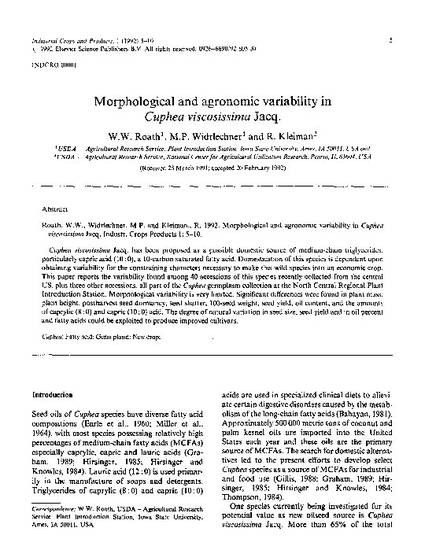
Article
Morphological and agronomic variability in Cuphea viscosissima Jacq
Industrial Crops and Products
Document Type
Article
Disciplines
Publication Date
9-1-1992
DOI
10.1016/0926-6690(92)90038-W
Abstract
Cuphea viscosissima Jacq. has been proposed as a possible domestic source of medium-chain triglycerides, particularly capric acid (10:0), a 10-carbon saturated fatty acid. Domestication of this species is dependent upon obtaining variability for the constraining characters necessary to make this wild species into an economic crop. This paper reports the variability found among 40 accessions of this species recently collected from the central US. plus three other accessions, all part of the Cuphea germplasm collection at the North Central Regional Plant Introduction Station. Morphological variability is very limited. Significant differences were found in plant mass, plant height, postharvest seed dormancy, seed shatter, 100-seed weight, seed yield, oil content, and the amounts of caprylic (8:0) and capric (10:0) acid. The degree of natural variation in seed size, seed yield and in oil percent and fatty acids could be exploited to produce improved cultivars.
Rights
Works produced by employees of the U.S. Government as part of their official duties are not copyrighted within the U.S. The content of this document is not copyrighted.
Language
en
File Format
application/pdf
Citation Information
W. W. Roath, Mark P. Widrlechner and R. Kleiman. "Morphological and agronomic variability in Cuphea viscosissima Jacq" Industrial Crops and Products Vol. 1 Iss. 1 (1992) p. 51 - 10 Available at: http://works.bepress.com/mark_widrlechner/58/

This article is from Industrial Crops and Products 1 (1992): 5–10, doi:10.1016/0926-6690(92)90038-W.